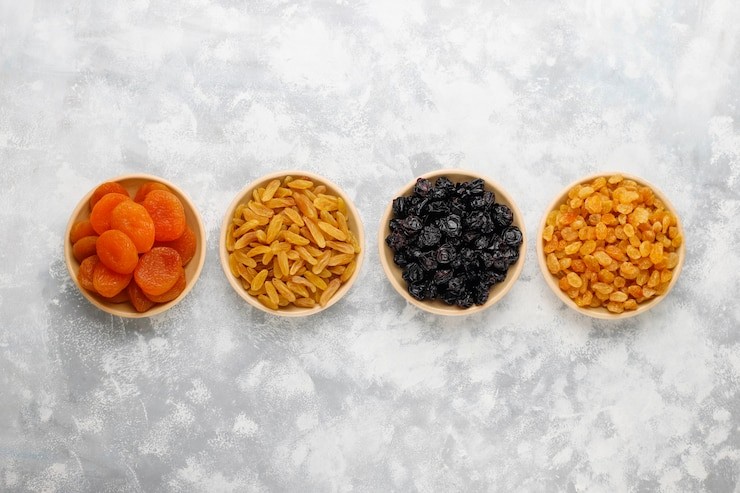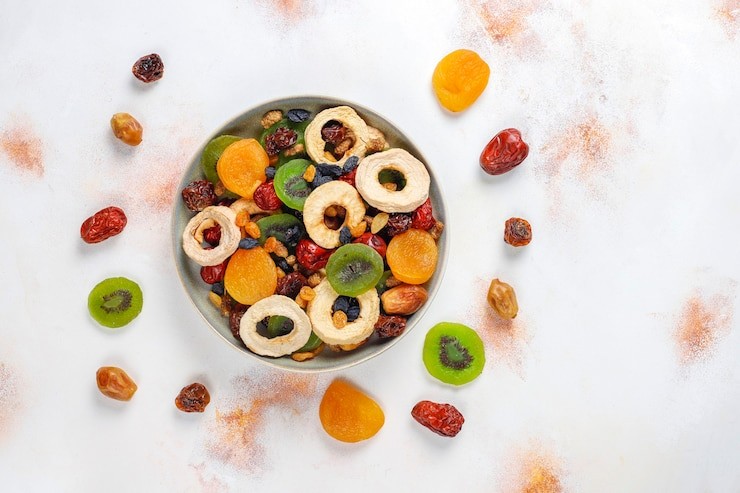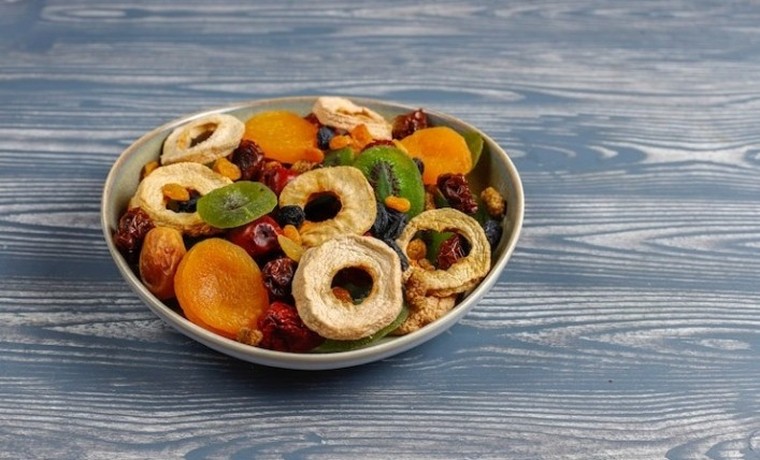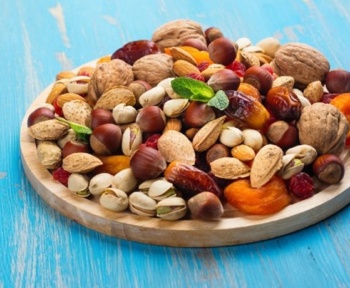Introduction
We all know that dried fruit can be a tasty and convenient snack, but it’s easy to forget that some can be surprisingly high in sugar. If you’re watching your sugar intake, this might feel like a bummer. But don’t worry! Plenty of dried fruit options won’t overload you with sugar.
In this blog, we’ll explore which dried fruits are naturally lower in sugar, why it matters, and how to make healthier choices without missing out on the yummy stuff. So, if you’re a dried fruit lover like me (guilty as charged), let’s figure out how to enjoy them without the sugar overload.
What Is Sugar Content in Dried Fruits?
Here’s the thing: dried fruits are just fresh fruits that have had their water removed. Sounds simple. Because there’s less water, all the sugars in the fruit become more concentrated. That means dried fruit tastes way sweeter than fresh fruit, even if the sugar is the same.
But here’s the kicker: some dried fruits have added sugar. Yup, that’s right. The dried fruit you pick up at the store might have some extra sweetness. So, even though it’s fruit, it’s not always as healthy as it seems. That extra sugar can sneak up on you, especially if you’re not checking the labels.

Factors That Influence Sugar Levels in Dried Fruits
There’s more going on with dried fruits than just their sweetness. Let’s take a quick look at some factors affecting sugar levels.
Drying Process and Sugar Concentration
When fruit is dried, the moisture is removed, and the sugars get a chance to shine. This makes dried fruits super sweet compared to their fresh counterparts. For example, a handful of dried mango can have the same sugar as a fresh mango. So yeah, it’s a big difference!
Variety of Fruits
Not all fruits are created equal in the sugar department. Some fruits, like grapes (hello, raisins!), naturally have more sugar than others. So, dried versions of those fruits will pack a bigger sugar punch. If you’re trying to watch your sugar, it helps to choose fruits that are naturally lower in sugar.
Added Sugars
Many dried fruits are sweetened to make them taste better or keep them fresh longer. It’s always a good idea to check the packaging to see if any added sugars are lurking in your favourite dried fruits. Some common offenders? Dried cranberries and pineapple. These can be sugary once the added sugar is factored in.

Dried Fruits with the Least Amount of Sugar
Okay, now for the good stuff. If you want to enjoy dried fruit without overloading with sugar, here are the best options to keep in your snack stash. (Pro tip: Check the labels for “unsweetened” when possible!)
Here’s a quick breakdown of dried fruits with the least sugar per 100g:

Sugar Content: Dried vs. Fresh
Knowing how much sugar is in your dried fruit compared to the fresh stuff is always good. Here’s a quick side-by-side of some common fruits:

As you can see, drying fruit amps up the sugar content. Fresh mango is sweet, but dried mango takes it to a new level—something to remember when reaching for that bag of dried fruit.
How to Choose Low-Sugar Dried Fruits
Not all dried fruits are created equal, so here’s how to pick the low-sugar ones like a pro:

1. Go for Unsweetened Versions
If you want to keep things low-sugar, always choose unsweetened dried fruits. These won’t add any extra sugar, so you’re just getting the natural sweetness from the fruit. Trust me, it’s worth it.
2. Check the Nutrition Label
Always glance at the nutrition label before buying any dried fruit. You want fruits under 10g of sugar per 100g to keep things balanced. That’s the sweet spot.
3. Choose Naturally Low-Sugar Fruits
Some dried fruits are just lower in sugar naturally. Apricots, cranberries (if unsweetened), and strawberries tend to be lower in sugar, so they’re your go-to fruits if you’re trying to keep sugar in check.
4. Avoid Sugared Dried Fruits
Some dried fruits are pumped up with extra sugar for taste or to help preserve them. Dried pineapple, for example, is often packed with added sugar. If you’re trying to be mindful of your sugar, steer clear.

Benefits of Choosing Low-Sugar Dried Fruits
Let’s take a quick look at why low-sugar dried fruits are a good choice:
Helps Control Weight
Low-sugar dried fruits won’t load you with excess calories, making them a good snack for weight control. Plus, they’re still satisfying, so you don’t need to worry about munching on empty calories.
Better Blood Sugar Control
Low-sugar dried fruits are a much better choice if you’re trying to manage blood sugar levels (or avoid those mid-afternoon sugar crashes). They don’t cause huge spikes, making it easier to stay balanced.
Packed with Nutrients
Even though you’re cutting back on sugar, you still get all the nutrients dried fruits offer. Fibre, vitamins, and antioxidants—it’s all there, just without the sugar overload.
Popular Low-Sugar Dried Fruits
Here are a few of my favourite low-sugar dried fruits:

Dried Avocado
Dried avocado is a superstar in low sugar, at just 0.2g of sugar per 100g. Plus, it’s packed with healthy fats, so it’s perfect for those on a low-carb diet. It’s also savoury, making it a nice change from the usual sweet dried fruit.
Dried Strawberries
These guys are naturally low in sugar, just 4.0g per 100g. They’re sweet but not overwhelmingly so. Plus, they’re full of antioxidants and vitamin C, which is always a bonus.
Dried Apricots
Dried apricots are a solid choice at 9.0g of sugar per 100g if you want something sweet but not overly sugary. They’re also high in fibre and vitamins, so you get a good dose of nutrients.
Dried Cranberries (Unsweetened)
If you’re trying to cut back on sugar, unsweetened dried cranberries are the way to go. At 4.0g of sugar per 100g, these little berries pack a punch of tart flavour and antioxidants without all the added sugar.
Dried Kiwi
Dried kiwi is an excellent option, with 7.0g of sugar per 100g. It’s sweet, but it won’t leave you feeling like you’re overindulging. Plus, it’s a good source of vitamin C, making it a healthy, nutrient-packed choice.
How to Add Low-Sugar Dried Fruits to Your Diet
Getting low-sugar dried fruits into your diet is effortless. Here are a few fun and simple ways to enjoy them:
- Toss them in your morning oatmeal or smoothie for a little extra sweetness without the sugar rush.
- Top your salad with dried strawberries or apricots to add flavour and texture.
- Mix them into a homemade trail mix with nuts and seeds for a healthy snack.
- Add them to yoghurt or ice cream for a guilt-free treat.
Expert Opinion: What Nutritionists Say About Low-Sugar Dried Fruits
I talked to nutritionist Sarah Jameson about why choosing low-sugar dried fruits is so important. Here’s what she had to say:
When it comes to dried fruit, it’s all about moderation and choosing wisely. Opting for unsweetened varieties and fruits that are naturally lower in sugar can help you enjoy the benefits of dried fruit without going overboard on sugar. My go-to options are dried apricots, strawberries, and cranberries—check the label to avoid added sugars!”
Conclusion
Choosing the right dried fruit can make a big difference, especially regarding sugar. Stick with unsweetened varieties of naturally low-sugar fruits like dried avocado, apricots, strawberries, and cranberries, and you’ll be enjoying all the tasty benefits without the sugar overload. Whether you’re snacking on them or adding them to recipes, these fruits are a healthier option to satisfy and energise you. So, go ahead and stock up on these sweet yet low-sugar dried fruits, and enjoy a healthy snack without the guilt!
FAQs
Yes, you can dry most types of fruit in the oven. However, some fruits work better than others. Apples, bananas, strawberries, mangoes, and pineapples are some of the best options. Just make sure to slice them evenly, and for fruits like apples or bananas, consider dipping them in lemon juice to prevent browning.
The time it takes to dry fruit in the oven depends on the fruit type, the slice thickness of the slices, and the temperature setting. Generally, it can take anywhere from 6 to 12 hours. Checking your fruit periodically and rotating the trays for even drying is essential.
You don’t need a dehydrator! Your oven can do the job just fine. Set it to a low temperature (between 130°F and 200°F), and with some patience, you can achieve perfectly dried fruit. A dehydrator is excellent, but an oven is a simple and cost-effective alternative.
Once your fruit is dried, let it cool completely before transferring it to airtight containers. Glass jars, resealable bags, or vacuum-sealed bags work great for storage. Store the containers in a cool, dark place, and your dried fruit can last for several months.
Absolutely! The beauty of drying fruit at home is that you have complete control over the process. You don’t need to use any added sugars or preservatives. Slice the fruit and dry it slowly at a low temperature to preserve its natural flavor.





